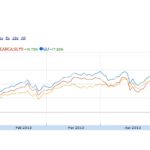Can you make a perfect, permanent portfolio out of four asset classes? One issuer, Global X, wants to do just that by turning Harry Brown’s 1980s permanent portfolio into the Permanent Portfolio ETF (PERM).
Permanent Portfolio in Practice
The permanent portfolio is made up of only four asset classes – gold, silver, equities, and US Treasury securities. The ideal permanent portfolio has an nearly equal-weighting of investments, with each asset class making up one-fourth of the portfolio.
The Permanent Portfolio is accentuated with annual rebalancing. In a year where stocks outperform and gold lags, assets would be removed from stocks to be placed in gold. This rebalancing element is the key to the Permanent Portfolio’s impressive historical performance.
Here’s a 10-year chart of the Permanent Portfolio’s performance as a mutual fund (PRPFX). MorningStar also includes the performance of benchmarks most relatable to the Permanent Portfolio mutual fund:

Keep in mind that this mutual fund, though it operates much like the exchange-traded fund, has a higher expense ratio and some differences in investment methodology.
Permanent Portfolio ETF vs. Mutual Fund
The ETF is not a perfect match of the Permanent Portfolio mutual fund. In particular, the ETF deviates from the mutual fund to purchase individual US securities rather than whole market indexes.
Below I’ve listed the asset classes and to what weight each is given in the Permanent Portfolio ETF as outlined in the prospectus:
- U.S. Large Cap Stocks – 9 percent
- U.S. Small Cap Stocks – 3 percent
- International Stocks – 3 percent
- U.S. Real Estate Stocks – 5 percent
- U.S. and Foreign Natural Resource Stocks – 5 percent
- U.S. Treasury Securities with 20+ years to maturity – 25 percent
- U.S. Treasury Securities with less than 3 years to maturity – 25 percent
- Gold – 20 percent
- Silver – 5 percent
Stock allocations will be decided on by the manager, and active selection is to be assumed. The fund disclosed in its prospectus that it will follow through with the original plan of the Permanent Portfolio to rebalance annually. However, the fund does retain the right to rebalance in the event of unusually large performance for a particular asset class, an event not well defined. I find it highly unlikely the fund would rebalance more than once per year in direct contradiction to the strategy of the original Permanent Portfolio.
Here’s how the mutual fund divides funds between asset classes:
- Stocks (aggressive growth companies) – 15 percent
- Natural resources and foreign real estate – 15 percent
- Swiss Francs – 10 percent
- Gold – 20 percent
- Silver – 5 percent
- Treasuries – 35 percent
Should You Buy the ETF or the Mutual Fund?
Either the ETF or the mutual fund will outperform the other at various times in the future. The funds have an equal preference for gold and silver, so neither gold nor silver will be a driver of differing investment performance.
The mutual fund’s insistence on Swiss Francs is a bit of an odd-ball. The Swiss Franc may have been a differentiated currency before the Swiss joined the International Monetary Fund, a period in which the Swiss National Bank held substantial gold and silver holdings relative to its money supply. Today, however, the Swiss National Bank is very different, having initiated actions to sell unlimited quantities of the Swiss Franc for Euros to moderate the EURCHF exchange rate.
Investors would be wise to see the Swiss Franc holdings as dead-weight, low-yielding assets that are likely to drag down performance. The Swiss National Bank has every incentive to halt the Franc’s impressive rally against global currencies in the past 5 years.
All things considered, the mutual fund is perhaps more resistant to US dollar inflation, given the smaller positions in Treasury securities. However, the 23 basis point differential in fees between the ETF (48 bp annually) and the mutual fund (71bp annually) is likely to erode any tactical advantage ingrained in the Permanent Portfolio mutual fund. Additionally, currency risk from the Swiss Franc is a poor risk-to-reward gamble, one which is likely to reduce returns in the short-run while offering no substantial upside.
Permanent Portfolio Pros and Cons
Obviously the permanent portfolio is a very unique concept. Let’s run through a few of the benefits of using the permanent portfolio as an alternative investment ETF and a long-term savings vehicle:
- Heavy Holdings of Alternative Asset Classes – Very few asset managers would keep 25% of a portfolio in precious metals, but in the last 10-year period, both silver and gold have vastly outperformed any other asset class. This is both an advantage in that investors have significant exposure to alternative asset classes, but a downfall in that precious metals are an “on-or-off†play, where they’re hot when they’re hot, and very cold for years when they’re cold.
- Rebalancing – The rebalancing characteristic of the Permanent Portfolio ETF is what sets it apart. By rebalancing annually to reset each asset class to 25% (stocks and precious metals) or 50% (fixed-income) of the portfolio, winners are cut to double-down on losing assets. This allows the fund to capture profits in secular bull markets (bonds and gold in the last decade, for example) while protecting investors from serious downside by taking profits out of runaway asset classes each year. I would say the rebalancing element is more of an advantage than a disadvantage.
- Simplicity – The permanent portfolio is designed for simplicity by balancing risks among very differentiated asset classes. In the long-run, a permanent portfolio would be an excellent wager; however, whenever the strategy outperforms or underperforms typical stock and bond portfolios, it is likely to do so for extended periods of time. The mutual fund lagged typical allocations in the 1980s and 1990s, only to outperform similar benchmarks during the 2000s for a larger total return.
- Inflation loss – The Permanent Portfolio is hardly a perfect hedge to inflation. An increase in expected inflation and US government default risk could substantially affect investment returns in US Treasuries. It’s impossible to say whether the deficit will be immediately hedged by stocks (which have their own rate risks as businesses finance themselves on dollar-denominated debt markets) or silver and gold (which can be both inflation hedges, but also popular “fear†trades.)
All in all, the Permanent Portfolio is nothing short of unique. Designed for the ultimate balance between equities, income, and alternative asset classes, it’s a product without any close comparison. The decision to invest in such a blend of assets is your own; however, it should be said that investors should pay close attention to the costs of employing this strategy. The ETF is less expensive, but any ETF trade creates a flat-rate commission charge. The mutual fund has a higher long-run cost of carrying, but is free to purchase with most online discount brokers.
Disclosure: The author has no position in any of the tickers listed above.











{ 0 comments… add one now }